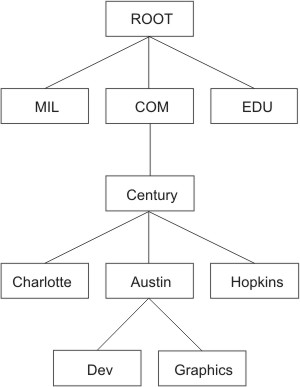Naming authority
In a flat network, all hosts in the network are administered by one central authority. This form of network requires that all hosts in the network have unique host names. In a large network, this requirement creates a large administrative burden on the central authority.
In a domain network, groups of hosts are administered separately
within a tree-structured hierarchy of domains and subdomains. In this
case, host names need to be unique only within the local domain, and
only the root domain is administered by a central authority.
This structure allows subdomains to be administered locally and reduces
the burden on the central authority. For example, the root domain
of the Internet consists of such domains as com (commercial
organizations), edu (educational organizations), gov (governmental
organizations), and mil (military groups). New top-level
domains can only be added by the central authority. Naming at the
second level is delegated to designated agents within the respective
domains. For example, in the following figure, com has
naming authority for all commercial organization subdomains beneath
it. Likewise, naming at the third level (and so on) is delegated to
agents within that level. For example, in the Domain Structure of
the Internet figure, Century has naming authority for its subdomains
Austin, Hopkins, and Charlotte.

Century's Austin subdomain might also be divided into zones, for
example, Dev and Graphics. In this case, the zone austin.century.com has
all the data contained in the domain austin.century.com,
except that which was delegated to Dev and Graphics. The zone dev.century.com would
contain only the data delegated to Dev; it would know nothing about
Graphics, for example. The zone austin.century.com (as
opposed to the domain of the same name) would contain only that data
not delegated to other zones.